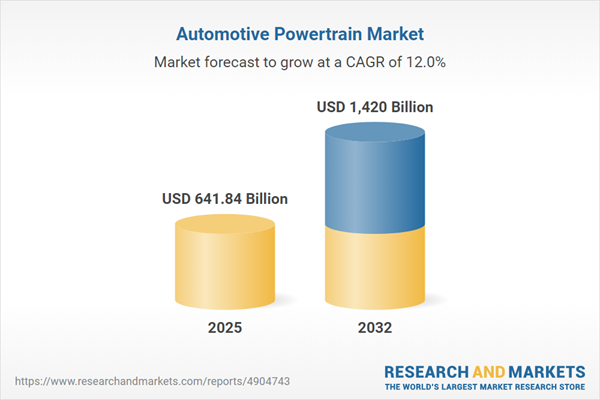Speak directly to the analyst to clarify any post sales queries you may have.
Amid rapid technological change and evolving regulations, the automotive powertrain market is entering a period of deep transformation. Senior decision-makers must manage growing complexity, balance operational resilience with innovation, and identify opportunities for sustained competitiveness.
Market Snapshot: Automotive Powertrain Market Outlook
The global automotive powertrain market is set for robust expansion, with an upward trajectory from USD 573.42 billion in 2024 to USD 641.84 billion in 2025, projected to reach USD 1.42 trillion by 2032. This reflects a compound annual growth rate of 12.01%. Momentum across the sector stems from increased investment in vehicle electrification, adaptive regulatory frameworks, and intensifying industry competition. Executives are evolving their strategies to align with changing emissions policies and shifting customer needs. Critical developments include a surge in strategic alliances among OEMs, component suppliers, and technology partners, driving compliance and competitiveness across all automotive market segments.
Scope & Segmentation: Automotive Powertrain Market Analysis
This report equips industry leaders with actionable intelligence spanning the entire automotive powertrain value chain. It highlights current trends, breakthrough innovations, and strategic considerations across technology, region, and application. Key areas include:
- Powertrain Types: Coverage extends from battery electric systems, advanced hybrid architectures, and hydrogen fuel cells—including both proton exchange membrane and solid oxide designs—to internal combustion engines, assessed for integration in both light and heavy vehicle classes.
- Vehicle Categories: Passenger cars—inclusive of hatchbacks, sedans, and SUVs—and commercial vehicles such as vans, pickups, and tractors. Segment analysis evaluates operational demands, regulatory pressures, and adaptation to sector-specific environments.
- Key Components: Analysis includes lead-acid, lithium-ion, and nickel-metal hydride batteries alongside electric motors, power electronics, emissions and combustion management systems, and energy-focused transmission technologies that enhance efficiency.
- Application Channels: Both original equipment manufacturer (OEM) and aftermarket distributions are addressed, with emphasis on technology uptake, maintenance intervals, and lifecycle management strategies impacting long-term value and performance.
- Regions & Countries: The Americas, EMEA, and Asia-Pacific are examined, with illustrated focus on China, India, Japan, and Australia. The report explores how infrastructure development, local regulations, and market maturity influence adoption and investment patterns.
- Leading Companies Profiled: Strategic actions, collaborative partnerships, and innovation frameworks of core market leaders—Robert Bosch GmbH, Denso Corporation, Magna International, ZF Friedrichshafen AG, and Continental AG—are profiled to help benchmark best practices.
Key Takeaways for Senior Decision-Makers
- Electrification is shifting industry benchmarks, compelling procurement and supply functions to adapt quickly and strategically to ongoing technology advancement.
- Battery sourcing is now central in compliance planning and ensures resilience against supply shocks, supporting tailored product development for diverse clients.
- Hydrogen fuel cells expand decarbonization options and operational flexibility, especially valuable for organizations with a strong focus on innovation and sustainability.
- Broader deployment of advanced simulation and data tools is accelerating product cycles, enabling leaders to synchronize with new powertrain developments more effectively.
- Strengthened risk management and improved supplier engagement are responding to challenges in supply continuity and ensuring robust alliances throughout the value chain.
Tariff Impact: Navigating Sourcing and Manufacturing Strategies
Forthcoming U.S. tariffs, set for 2025, are prompting a strategic reassessment of sourcing and manufacturing within the automotive powertrain sector. Senior leaders increasingly consider regionalized production models, deeper supplier partnerships, and comprehensive cost analysis to manage regulatory uncertainties. This adaptive approach aims to safeguard operational continuity and ensure stability in the face of shifting global trade dynamics.
Methodology & Data Sources
This report employs a robust methodology integrating executive interviews, on-site inspections, regulatory assessments, scenario analysis, and infrastructure evaluation. These combined methods provide decision-makers with validated, data-rich insights for precision in strategic planning within the automotive powertrain market.
Why This Report Matters to Your Organization
- Gain a holistic perspective on operational and investment pathways, informed by comprehensive coverage of every stage of the powertrain market value chain.
- Strengthen compliance and optimize risk management, positioning leadership to act effectively despite volatile market forces and regulatory changes.
- Accelerate adoption of advanced technologies while integrating sustainability objectives, supporting competitiveness across both mature and emerging automotive markets.
Conclusion
With insights from this report, executives can refine strategic direction, enhance organizational resilience, and support the ongoing growth and transformation of the automotive powertrain sector.
Additional Product Information:
- Purchase of this report includes 1 year online access with quarterly updates.
- This report can be updated on request. Please contact our Customer Experience team using the Ask a Question widget on our website.
Table of Contents
3. Executive Summary
4. Market Overview
7. Cumulative Impact of Artificial Intelligence 2025
Companies Mentioned
The companies profiled in this Automotive Powertrain market report include:- Robert Bosch GmbH
- Denso Corporation
- Magna International Inc.
- ZF Friedrichshafen AG
- Aisin Seiki Co., Ltd.
- Continental AG
- Valeo SA
- BorgWarner Inc.
- Schaeffler AG
- Mahle GmbH
Table Information
| Report Attribute | Details |
|---|---|
| No. of Pages | 199 |
| Published | October 2025 |
| Forecast Period | 2025 - 2032 |
| Estimated Market Value ( USD | $ 641.84 Billion |
| Forecasted Market Value ( USD | $ 1420 Billion |
| Compound Annual Growth Rate | 12.0% |
| Regions Covered | Global |
| No. of Companies Mentioned | 11 |









